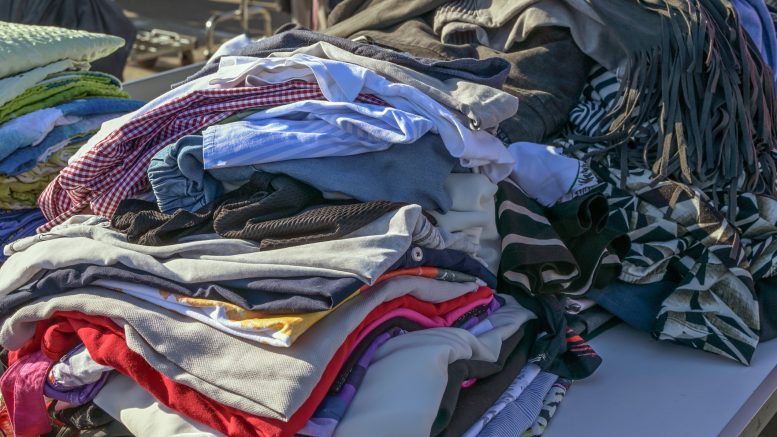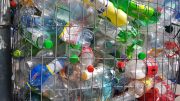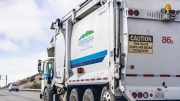As part of our continuing investigation into ways people in our state are working to increase recycling and reduce items filling our landfills, we caught up with Sen. Josh Newman, who represents District 29 (which encompasses parts of Los Angeles, Orange and San Bernardino counties).
Sen. Newman, before we do the deep dive into the circular economy, I’m hoping you can talk a bit about your personal history and philosophy. I haven’t checked all the biographies of the state senators, but attending Yale, serving as an artillery officer in the army, elected as state senator, being recalled and then coming back is not the typical career path. Can you talk a bit about how you got to where you are now?
I’m a regular guy, I graduated from college with a BA in history and I was intrigued about the service and wanted to go see what it was all about. So I served in the U.S. Army, as you mentioned, as an artillery officer. I was stationed in South Korea, in Hawaii, and then got out—and getting out brought me to California. At the time, I thought I would spend a couple of months here and go on my merry way, and that was 30-something years ago.

Since then, post-military, I’ve worked in a bunch of different fields and capacities. I worked in local politics a little bit in Northern California. I worked in the entertainment business for a little while, I worked in technology for almost a decade and a half. I then came to elected service, through my work, starting in 2012, around veterans. I got very interested in this question: Why young vets coming home from their service to Southern California were having so much trouble finding gainful employment, especially those who didn’t have any kind of residual issues from their service? That exposed me to a lot of elected people and I got kind of frustrated.
Then during 2016, my wife goaded me into running. She pointed out that our state senator was termed out and if I really wanted to change things, why didn’t I run? What she really probably meant was why didn’t I stop talking. That’s honestly how it happened. I didn’t know that our state senator was termed out. Throwing my hat in the ring, I won a very narrow election in 2016. It was, in fact, the closest election, and the most expensive election as well, in the state. That put me in harm’s way in 2017, when we as a legislature voted to raise California’s gas tax to account for its loss of purchasing power since the ’90s. So I was a target of a hyper-partisan and effective recall effort that cast me out of office in 2018.
I ran again, in 2020. In that time, even during my recall, I’m proud of the work that I’ve done. I did a bunch of of good, pragmatic problem-solving legislation, which I think brings me naturally to the work that we’re discussing today and some of the work I’ve done over the last couple of years around recycling the battery stock. The goal really is to try to align market forces and enroll market participants in ways that create greater scale and efficiency to recycle things that otherwise often are either shipped to landfills, or out of the country, for disposal that isn’t safe.
You’ve provided real leadership on environmental issues—in particular moving to a circular economy, with past battery bills and now the textile bill. Can you talk about your interest in the environment and why you’ve made it such a focus?
I’m a Democrat, as I mentioned, and also a pragmatist and a centrist by nature. It’s always been my thesis that there’s nothing mutually exclusive to environmental progress and economic development. The battery bill, all of these circular economy bills, actually fit neatly, I think, into that model, where they offer real potential for creating the scale and efficiencies that we need to solve certain problems. The battery bill we did last year was on top of a bunch of successive efforts to find a workable solution to battery disposal. The idea was to apply the extended producer responsibility concept that California has used for other difficult-to-recycle items. You mentioned carpets earlier, you know, and we’re looking at (existing EPR products like) tires, mattresses, and some pharmaceutical products as part of the model for SB 707. If you can create incentives and processes, you can make a big difference, keep things out of landfills and hopefully turn components back into reusable goods. That, I think, appeals to my pragmatic nature more than anything.
Let’s talk a little bit about a circular economy, how that process works and why you think it’s an effective way to use market forces to get environmental impacts.
Textiles is a really interesting space and there’s been a lot written recently about fast fashion and … it’s dangerous because many things are really inexpensive, because they are unsubstantial, or they’re made with artificial components that are really cheap, are petroleum-based products. It’s a well-known fact that roughly 90% of textile materials are recyclable, but only a very small share is actually recycled. That is mostly because we lack the circular structure. Textile components are going into landfills but it’s not because they’re not inherently recyclable, it’s because we haven’t built either those processes or created incentives in the market to do those things. Textiles are a perfect opportunity for a circular economy model if we can stand up a bunch of systems in place, but also incentives to support those systems. We’ve seen that done in standard recycling with metals, where there’s a really large and sophisticated system for sorting different kinds of metals that come through the recycling process. There are both buyers for those metals, and then takers for those end products. That’s precisely what we’re trying to do or to advance by way of a new model for textiles.
Let’s go back to the battery bill for a second, which just passed last year. I think some of the data showed just a tiny percentage of the batteries were being recycled correctly and the batteries were getting stronger and more dangerous in terms of processing. So how do you feel about how it’s unfolded? And how do you envision success in terms of the battery recycling?
This is a process that is clearly in its nascent stages. But to your point, think of literally the millions of batteries in all the devices that we count on in this modern age, every day. If you’re like me, or the average person, we have every intention of disposing of batteries and an awareness that what makes a battery carry an electric charge is innate to its materials, and those materials aren’t particularly good for the environment if they’re just tossed into the waste stream.
But we really lacked in California a good system for collecting those batteries in any sort of scaled way. What you typically had was your average citizen thinking ‘I want to throw batteries out,’ but they’d sit in a pile, or in a bag on your kitchen shelf or den. Then at some point, somebody would have that guilty moment where they thought, I still don’t know what to do with them and off they went, now kind of in a big pile, into the waste stream. So, what became clear to us, was all of the different participants in the battery life cycle had to have a reason and a structure to help adapt the system and abet that recycling.
The battery bill is a good model, at least up to now. We worked very deliberately with industry, with the California Retailers Association and the California Manufacturers Technology Association, among other stakeholders, to make sure that all of the different participants in the life cycle of a battery were fully apprised of what we had in mind. One of the difficulties of the bill was that initially, it didn’t really differentiate or decouple lithium ion batteries from disposable batteries and they have very different attributes, very different end uses that make the most sense. I (addressed) half of that supply with one piece of legislation and Assembly member Jackie Irwin took the other, so that it was cleaner.
CalRecycle is typically the agency that is assigned responsibility for managing these processes and they clearly have a lot on their plate. We have the challenges in California with the bottles and cans, everybody’s vaguely familiar with that. But more recently, really cutting-edge, groundbreaking legislation around plastics, is SB 54, from my colleague, Senator Allen. So, the question does get asked in conversations about my other prospective bills: How far along is CalRecycle? How much more can they handle by way of scope or responsibility for additional circular economy ideas? We’re working through that right now.
What are some of the major takeaways that you had on the opportunities and challenges of other circular economy bills?
The best, easiest thing for me is to relate it to our current bill, the textile bill. When you think of an industry as specialized, but also as universal as textiles, it’s not that hard to think through the value chain and realize how many people touch those goods. From manufacturing, to retail, distribution, to disposal—whether that’s repair and reuse, whether that’s recycling, whether that’s landfill. It became really obvious to us that the only way to build an extended producer responsibility model that worked was to engage those constituencies early, so not only were they fully apprised, but also hopefully, over time, fully invested. They understand not only their role, but the benefits to them, both directly as participants in this circular economy, but also indirectly in their eventual, or ultimate impact on the environment, in ways that affect their brand, their relationship with their users, their relationship with state governments and other jurisdictions like the EU. So that’s what we’re working on.
Batteries are probably harder, because they’re kind of universal, and yet not an easy thing to figure out who should be fully charged with and get an incentive to do the collection. That’s where CalRecycle comes in, and for the textile bill, that’s where the product resource organizations (PROs) are going to come in on our side to advise,inform and manage those processes.
Are there examples, like with the carpet bill, where the industry was clearly not acting in good faith in terms of what they were doing and how they were operating. Do you have any kind of things to make sure that doesn’t happen with either the battery bill or with the textile bill?
That’s an interesting question. I think you have to really look seriously at two things. One is incentives, and the other is penalties. And there has to be a balance of the classic kind of carrot and stick in that equation. Our thesis is, if you can create the right incentives and efficiencies, that addresses part of it, and then there have to be disincentives or consequences for not being a good actor. It’s interesting, because a lot of it is about finding the market point, the price point, where these things start to make sense.
Carpets is a fairly large dollar purchase for a consumer. So you have a natural temptation among sellers and producers to not incorporate the right EPR input on that. Textiles is interesting because it’s vast, right? So you can probably get by with a fairly small input into that purchase price. That’s one of the biggest things that we’re going to work through. It’s really important, especially across the whole value chain, to make sure that we’ve done this properly. The only way to do that is to engage all of the stakeholders on the production side: How much is too much? What’s the right number? How do you convey that to a consumer incorporated in your pricing? But on the other side of the equation, how do we then harvest that value so it creates incentives for people to (create) new industries for processing recycled textiles? Carpet is not an easy thing at all to recycle. But if you’ve been to a municipal refuse facility, you will see that they are segregating anything that looks like carpet in the right pile for a very different part of the waste stream. That’s at least some progress in a place like California.
For the consumer however, they’re buying the stuff—whether it be batteries, paint, oil—at the same stores and storing it in the same garage. They’re often taken into the same (waste) facilities, yet all the programs are run in silos. So do we need to do a rethinking of that? Is there an opportunity to have all the programs work under the same umbrella, where we can develop more collaborations to share the communication? Or does the way that they got their funding preclude any possibility of collaboration?
I appreciate your question—it’s a very good question because at the end of the day, the consumer has to have a good understanding of the impact of their consumer behavior on the environment, that they might have some impact depending on their purchasing behavior. So we’ve talked a lot in the textile bill about this concept of eco-modulation, and how to provide a basis so that everybody involved in the value chain, especially at the retail level, can convey to the customer you’re paying x but some component of that will go to the responsible reuse or recycling of this product. Then people can score one product versus another, and amend their consumer behavior accordingly. But without that broader context, it really is hard because the average person goes on their merry way. They’re not connecting their purchase behavior with its interim and ultimate impacts on systems like the environment. So part of it has to be education, and not necessarily directly connected to the economics of circular economies. We have to create an awareness and a receptivity … that there’s a larger external benefit depending on how those products will be handled in a waste stream.
For me, seeing the vision of how the circular economy has come into being and how it’s going to change manufacturing, develop new kinds of products, and impact the environment is really inspiring. Then to see what’s been unfolding over the last several years—new legislation is coming that is adding to a certain momentum—is going to put us in an exciting new place. But we need to get the public engaged in seeing that kind of vision. And then the second difficulty is every locale has different structures in terms of what they can recycle, what they can use, etc. You can’t have a one-size-fits-all, you need to adapt it with the local environment. That seems really intriguing to me, but then I think the end result is: here’s the jobs created, here’s how it’s helping the environment, here’s the goals that we have locally but we need to put it together somehow.
Precisely. The truth is most people don’t know what goes into their textiles, into their apparel. You know vaguely this is cotton, this is a cotton blend, this is a synthetic, but nobody knows really what Dacron is made of. I think the plastics example is very relevant, because most people are now—encouragingly—coming to an awareness that not every category of PET is equally recyclable. I think because of that awareness there is now a receptivity to reducing the types of plastic that go into key commodities that will be products. If you can do that, you can instigate a lot of innovation. But if you don’t, then it’s completely still kind of variegated, you get what we’re still getting by way of plastics recycling, where it doesn’t matter that somebody has a plastics bin at their house and they adhere as much as they can to the requirements if when it gets to the refuse facility, only two of the seven types of plastics have a market. That’s one of the unfortunate facts of the status quo. But I think California gets credit for continually trying to push past that. … We need to inform the people of what is actually possible and is being done.
This is the promise of the circular model around textiles. If you had a larger market for repair, you would have incentives to take certain kinds of textiles out of the waste stream or never have them in there in the first place. If you had clear labeling, and standards around components going into textiles, you could sort those more effectively. You would have buyers that currently don’t exist, that would take advantage of the opportunity to create a market around those things. So again, that’s the hope and you can’t have a buyer and a market for everything, right? So we have to simplify and streamline, but in ways that don’t run counter to consumer behavior, marketing settings, manufacturer, or those incentives as well.
What questions should I have asked that I didn’t?
I can tell you one of them: the implementation. This question about what’s the right interplay between stakeholders, PROs and CalRecycle. Because I think that’s a very relevant question. That is something we’re working on, and it’s one of the reasons why we didn’t push the bill faster through the system last session. Jessica Matlock, my legislative aide can answer that question, it gets to some of your questions about how to do this well.
Jessica: Absolutely. I think that one of the promises of the EPR model is the long lead time to get into it. And the way the agency enrolls participants in the system, the manufacturers then come up with a plan to actualize the promises of the legislation. CalRecycle is the one that gives the seal of approval. So it’s not this kind of top-down, here’s the agency directing the market how to act. It’s the market telling the agency how they can reasonably comply with the legislation..
Again, I think it’s really a cool opportunity to be creating these markets that don’t exist yet for collectors and recyclers and there’s also no mandate in this bill that the textiles go back into textiles. A lot of it will probably end up being shredded and used for insulation, which is also a really important component. So rather than having that come from virgin material, coming from the recycled components of this program, even that is waste reduction, getting it out of the landfill. Also, trying to decrease the amount of waste that’s going overseas. I just had a conversation with the OR Foundation, that works out of Ghana, this morning, trying to use this bill as a leverage point and getting better mixed bales that get shipped over there. One component of the bill that we already modified was the definition that it’s unwanted by the consumer, instead of unusable. That broadens out the category of the product coming into the program. Because unusable that’s kind of sticky, how do you define that, but unwanted is any textile that’s going to go to Goodwill, for example, or any collections point. It might still be perfectly good and then that can get sorted out and resold on the second hand market or upcycled, or repaired, and then see what really needs to get recycled at the fiber level. At the beginning of the program, some stuff is still going to go to the landfill, but it’s about diminishing that waste stream over time while building out the markets to more effectively recycle and manage textile waste.
Anything else you would like to add, Senator?
I would add that it’s been interesting to have conversations with some of the largest retailers, which is the IKEAs of the world, the Targets, North Face and a bunch of others. They’ve said: we’re already attentive to this, we’re already using environmental measures in our marketing, we’re interested in both being a responsible supplier of goods into the circular economy but we also want to be a purchaser if we can of recycled or recyclable components. They want to control their own supply chain in ways that make them not just efficient, but profitable. So again, I think the EPR model is best served by being as consultative as possible as you work your way into it. At the end of the day, CalRecycle is going to administer this but hopefully, we’re going to collectively design something for them that has the best chance of initial success, and then streamlining and efficiency as we move forward.
Jessica: Again, I think the model allows for a lot of flexibility. Some brands already have really good take-back programs. Patagonia is already using recycled content within their material. So for them, their fees to comply might be much smaller than another organization. Obviously, that will be determined by the PRO and CalRecycle, but they might not have to pay too much because they’re already making good on their promises and contributing to the circular economy. But this allows—rather than brands doing it individually and siloed—for them to collectivize those processes and pay into a broader infrastructure to get more recycled content as well. There’s an increasing demand for it from consumers but right now there’s not really the system. So this will this will help bolster that and create that new vision.
Thank you both for your time today.






Be the first to comment on "A Q&A with Senator Josh Newman: How the circular economy effort in California is making a major impact on the environment"